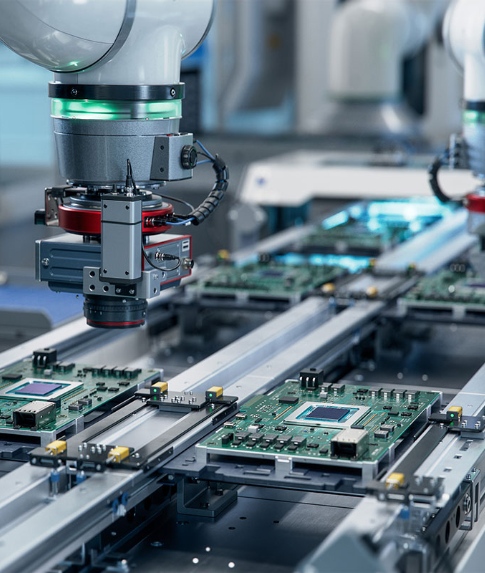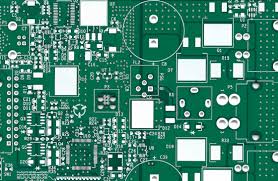



Immersion Silver(ImAg)By chemically depositing a 0.1-0.4 μm dense silver layer on the copper surface, the PCB performance is significantly improved: welding strength is increased by more than 30%, contact resistance is reduced to below 10 mΩ, and signal transmission integrity is enhanced by 20%. The solder joints processed by this process perform well in the -40℃~125℃ extreme temperature cycle test, with a failure cycle of up to 1,200 times, which is 140% higher than the traditional gold plating process.
However, the silver immersion process has obvious material property defects. The silver layer has a strong affinity with sulfur ions (S²⁻). In an environment with humidity >60%RH and temperature >25°C, the sulfurization reaction rate increases exponentially. This chemical reaction will cause Ag₂S compounds to form on the surface of the silver layer, significantly increasing the contact resistance and affecting the stability of signal transmission.
Industrial control PCBsusually work in a high reliability environment and have strict requirements on material stability. The main risks of immersion silver process in such applications are:
1. Environmental sensitivity: Temperature and humidity fluctuations during production, storage, and transportation can easily induce vulcanization reactions;
2. Performance degradation mechanism: Sulfurization products cause the conductivity of the silver layer to decrease and the contact resistance to increase abnormally;
3. Long-term reliability threat: Even a small amount of sulfurization can cause the signal transmission bit error rate to increase, affecting the stability of the control system.
Establish scientific storage environment control standards and implement three-level protection measures:
1. Basic protection: The warehouse is equipped with an industrial dehumidification system (dew point temperature <-20°C) to maintain a constant temperature of 18-22°C ± 1°C;
2. Intermediate protection: Use aluminum foil composite packaging bags, silica gel and molecular sieve mixed desiccant, and set a 20%RH humidity indicator card warning line;
3. Advanced protection: Key components are stored in nitrogen cabinets (O₂ concentration <500ppm), and dew point indicators are monitored regularly (≥2 times per week).
This classification system allows flexible selection of protection levels based on PCB storage cycles and environmental conditions.
In view of the reliability requirements of industrial control PCB, a gradient coating technology route is recommended
|
Protection level |
Coating material |
Thickness range |
Core Advantages |
|
Basic level |
Acrylic UV Curing Coating |
3-5μm |
Fast curing, suitable for consumer electronics |
|
Advanced |
Epoxy-polyurethane hybrid coating |
8-12μm |
Excellent sulfide resistance, suitable for industrial control |
|
High-end |
Nano-siloxane composite coating |
15-20μm |
Super strong barrier performance, used in automotive electronics |
The coating process needs to strictly control the uniformity of film thickness and surface coverage to ensure protection without blind spots.
Improving the quality of the silver layer by optimizing the silver immersion process parameters:
1. Pretreatment: plasma cleaning (power 300W, time 90s) is used to control the copper surface roughness Ra 0.8-1.2μm;
2. Silver precipitation process: maintain Ag⁺ concentration at 0.8-1.2g/L, and precisely control pH value at 4.8-5.2;
3. Post-treatment: Ultrasonic cleaning (40 kHz, 5 min) was performed using a mixture of IPA and deionized water (3:7 ratio).
Parameter optimization can significantly improve the density of the silver layer (up to more than 97%) and delay the progress of the sulfurization reaction.
In the future, the protection technology of immersion silver process will evolve towards intelligence:
1. Self-repairing materials: Develop coatings containing microcapsule repair agents to achieve automatic repair of vulcanization damage;
2. Online monitoring system: using Raman spectroscopy to achieve real-time detection of the degree of vulcanization;
3. Composite protection structure: Combining immersion silver and OSP processes to build a "metal-organic" double-layer protection system.
These technological innovations will further enhance the long-term reliability of immersion silver processes in the field of industrial control PCBs.
The double-sided characteristics of the silver immersion process require companies to take systematic protective measures in their applications. Through storage environment control, surface coating technology upgrades and process parameter optimization, the sulfurization problem can be effectively solved to meet the stringent requirements of industrial control PCBs for high reliability. With the application of new materials and new technologies, the stability of the silver immersion process will be further improved, providing better solutions for electronic manufacturing.
Our hours
24H